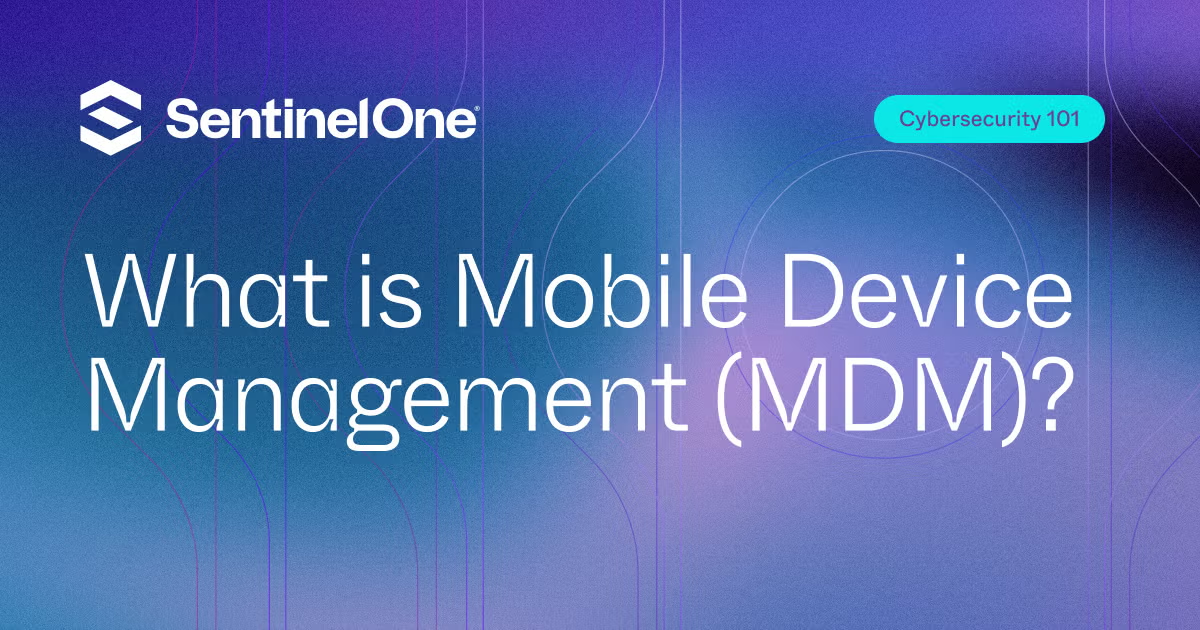Mobile Device Management (MDM) is a security strategy for managing and securing mobile devices within an organization. This guide explores the principles of MDM, its benefits, and best practices for implementation.
Learn about the tools and techniques used in MDM to enforce security policies and protect sensitive data. Understanding MDM is crucial for organizations to ensure the security of their mobile workforce..

Why Mobile Device Management Is Important
Corporate and personal mobile hardware are commonplace. Business productivity goals count on the successful deployment and use of smartphones, laptops, tablets, and wearables. Employees can work wherever they are without the bottleneck of wasted time when they are on the go, whether traveling, working from home, or on the bus, shuttle, or train. A business can’t go back to strictly in-office work without losing its competitive advantages.
But businesses also can’t afford not to address the increasing concerns of data breaches, leaks, and theft of devices. As such, MDM is a core entity in IT departments’ work in provisioning, inventory, management, monitoring, and developing the devices, software, and infrastructure throughout its lifecycle, both in the corporate perimeter and the cloud perimeter that services these devices.
An MDM solution scales the number and types of devices an organization can support, offering user personalization and flexibility while improving productivity.
How Mobile Device Management Works
An enterprise mobile device management system of software for portable devices encapsulates a secure place on the smartphone or laptop for access to sensitive corporate data. The software provides these devices with a virtual bubble or other secure perimeter around the corporate data and the infrastructure that provides it. It keeps the data safe from the user back to the enterprise.
Though the data may not live on the phone, the employee can use it as though it were. When closing the encapsulation or virtual instance surrounding the data, no secure data is left on the phone. The business uses software and processes that make data available and safe, while policies dictate what the MDM technology can and can’t do.
The device is the focal point of the MDM approach. The technology is moving toward a mobile security and endpoint management approach, encompassing the phone as an endpoint device. This technology is now user-centric. An MDM program provides users with a dedicated device or software for their personal device. Users receive role-based access to enterprise information and approved corporate applications, such as email clients, and a secure Virtual Private Network (VPN), which hides the employee and company traffic using proxies and encryption. The device’s GPS tracking is enabled so it can be located and wiped clean in the case of potential theft or loss. Applications are protected with user credentials, including multi-factor authentication (MFA).
Once fully engaged with the device, user, and network, MDM can monitor application behavior for suspect activity and protect business-critical data. As AI increasingly analyzes the data for security purposes, the devices are kept free of cyber threats and malware.
An organization assigning an MDM-enabled device equipped with a data profile, VPN, and applications offers the employer the most control. IT security can track the device, monitor its use, troubleshoot it in the event of errors or malfunctions, and reset the device so that all data and access are lost to potential thieves and cybercriminals.
Leading the Way in Endpoint Security
See why SentinelOne has been named a Leader four years in a row in the Gartner® Magic Quadrant™ for Endpoint Protection Platforms.
Read Report
Components of Mobile Device Management Tools
MDM’s capabilities, features, and components include hardware tracking, application security, identity access management (IAM), and endpoint security. Each enrolled and provisioned device is configured to include GPS tracking and comparable programs. The program suite enables the IT security team to update and troubleshoot devices quickly. IT can use the programs to detect and report high-risk or non-compliant devices and remotely lock or wipe those when lost or stolen.
IT leads the way in procuring, deploying, and supporting devices suitable for the workforce. They ensure deployment with the appropriate applications and software, including the procured operating system. Installed applications cover user productivity needs, security and data protection, and backup and restoration tools.
Application security works in tandem with containerization, which wraps apps in a virtual bubble so they are not engaging directly with the operating system kernel on the device. Instead, those use the wrapper to interact with the needed OS resources. It is an example of containerization, similar to a virtual machine. However, a container is much more independent of the underlying hardware. Application security determines whether an app needs authentication, whether an employee can copy data from the app, and whether the user can share a file.
Identity Access Management (IAM) technology works with the MDM to permit the enterprise to manage device user identities. It can use these technologies to fully regulate user access within the organization using single sign-on (SSO), MFA, and role-based access.
An endpoint security platform like Singularity™ Endpoint protects all devices and connections to those and the corporate network, including wearables, Internet of Things (IoT) intelligent devices, and sensors. Organizations can enforce network security using tools such as antivirus, network access control (NAC), URL filtering, cloud security, and incident response when these technologies identify an attack or breach.
BYOD and MDM
Employees are often more productive with their own familiar devices. Bring Your Own Device (BYOD) policies make it possible while keeping the enterprise and its intellectual property safe. By allowing employees to use their own equipment, a company can keep them happy and working productively, while also saving on hardware purchases.
Enterprise Mobility Management (EMM) is a broader application of MDM. EMM includes application and endpoint management with BYOD. EMM scales with new AI-enabled security features for real-time insights and event alerts about many malicious device behaviors across the fleet.
Organizations can integrate MDM and EMM by unifying endpoint management solving IoT and other mobile device security challenges. Unified Endpoint Management (UEM) controls the mobile device environment, endpoints, and user and enterprise data. Enterprises can scale solutions to support variegated platforms such as Apple and Android. AI empowers security analysts and their decision-making process to achieve quicker response times.
Mobile Device Management Best Practices
Following best practices for MDM brings visibility to endpoints, users, and data. MDM best practices enable observability by monitoring mobile device users while managing them with security policies and controls. Centralized management of applications, user privacy, and report automation with a clear understanding of policies among the workforce achieves successful monitoring and visibility.
MDM should automate reporting and inventory for enrolled devices and content with daily updates.
It also ensures current reports by synchronizing device inventory data on a regular schedule. Reports should be customizable to the organization’s unique needs.
MDM should be a cloud-based solution with no CAPEX to hinder the ramping of the solution. Likewise, MDM data and reports should be centrally searchable. Cloud-based MDM eliminates CAPEX and enables a pay-as-you-go utility solution for MDM for quick ramp-up and cost-effective device management. Cloud-native MDM makes master data and insights available through a centralized data catalog for searching data across the organization.
Discover Unparalleled Endpoint Protection
See how AI-powered endpoint security from SentinelOne can help you prevent, detect, and respond to cyber threats in real time.
Get a DemoConclusion
MDM keeps mobile device fleets secure and manageable from a centralized cloud platform. By monitoring and controlling users, data, and devices, the organization can gain visibility into security issues and collect and review inventory data. MDM maximizes user productivity while easing support for IT security. To know more about the Singularity™ Endpoint platform, feel free to reach out to our team.
MDM FAQs
Mobile Device Management (MDM) software monitors, manages, and safeguards each smartphone, laptop, tablet, and wearable enrolled in the MDM program. Employees can access enterprise data on their devices wherever they are. Corporate data stays secure, and enterprises comply with regulations while enforcing pin/passcode and screen lock policies, limiting access to role-based work profiles and maintaining encryption.
MDM enables visibility into device ownership, configurations, applications, security, device warranty data, and location. MDM solutions do not typically record web surfing history. Ask IT security about the privacy employees can expect on their enrolled devices.
Recognized MDM standards include the NIST SP 800-124 and standards work from the CIS, CIS Controls, and the OWASP Mobile Security Project.

